AMSC700 Case Study: Maximizing Sales Through Iconic's Supply Chain
VerifiedAdded on 2022/11/09
|12
|3364
|332
Case Study
AI Summary
This case study examines The Iconic, a leading Australian retail brand, and analyzes its supply chain management and logistics strategies. The report investigates how The Iconic maximizes its sales through technology integration in its supply chain, exploring various stages such as distributors, suppliers, and logistics. It also considers benchmarking matrices, integration considerations, and value generation within the supply chain. The study highlights the company's use of technology, including SPS Commerce, to enhance communication, coordination, and delivery efficiency. Furthermore, it discusses key supply chain drivers like facilities, inventory, transportation, information, sourcing, and pricing. The analysis underscores the importance of integration, particularly through systems like QuickBooks, and examines how these elements contribute to The Iconic's overall success in the retail market.

SUPPLY CHAIN AND
LOGISTIC MANAGEMENT
LOGISTIC MANAGEMENT
Paraphrase This Document
Need a fresh take? Get an instant paraphrase of this document with our AI Paraphraser
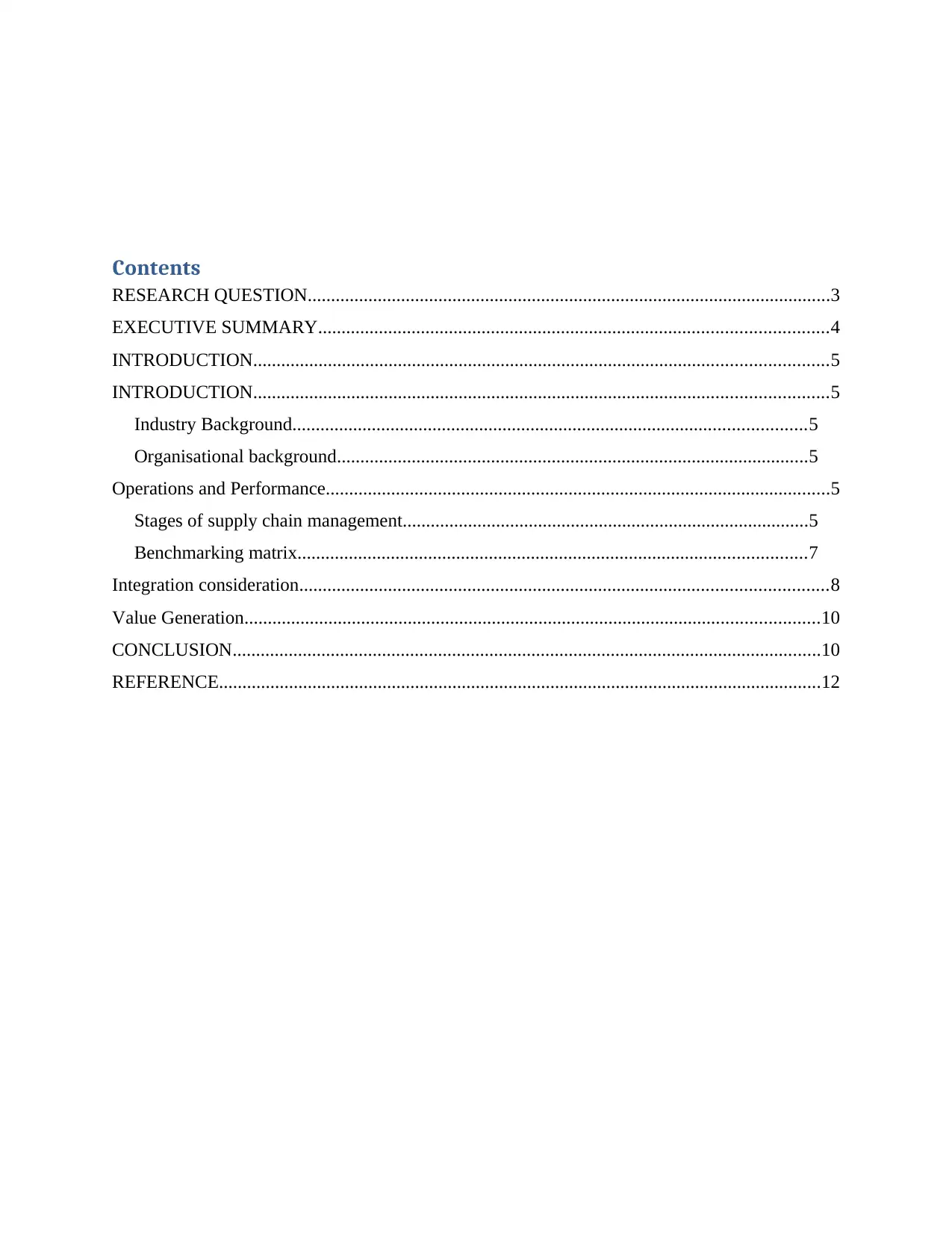
Contents
RESEARCH QUESTION................................................................................................................3
EXECUTIVE SUMMARY.............................................................................................................4
INTRODUCTION...........................................................................................................................5
INTRODUCTION...........................................................................................................................5
Industry Background..............................................................................................................5
Organisational background.....................................................................................................5
Operations and Performance............................................................................................................5
Stages of supply chain management.......................................................................................5
Benchmarking matrix.............................................................................................................7
Integration consideration.................................................................................................................8
Value Generation...........................................................................................................................10
CONCLUSION..............................................................................................................................10
REFERENCE.................................................................................................................................12
RESEARCH QUESTION................................................................................................................3
EXECUTIVE SUMMARY.............................................................................................................4
INTRODUCTION...........................................................................................................................5
INTRODUCTION...........................................................................................................................5
Industry Background..............................................................................................................5
Organisational background.....................................................................................................5
Operations and Performance............................................................................................................5
Stages of supply chain management.......................................................................................5
Benchmarking matrix.............................................................................................................7
Integration consideration.................................................................................................................8
Value Generation...........................................................................................................................10
CONCLUSION..............................................................................................................................10
REFERENCE.................................................................................................................................12

RESEARCH QUESTION
The iconic is the leading brand in the retail sector in Australia. It has initiated its business
operation from the year 2011 and with its effective supply chain management and logistics, the
company has successfully expanded its market to the global world as well. At present, the
company has total of 1000 brands which provides different types of style, design and fashion to
the people. Furthermore, the company has strong technological department who are bringing new
and innovative technologies for the products and services. The following is the research question
which is to be considered for this report:
How the Iconic is maximising its sales by introducing technology in supply chain management
and logistics?
The iconic is the leading brand in the retail sector in Australia. It has initiated its business
operation from the year 2011 and with its effective supply chain management and logistics, the
company has successfully expanded its market to the global world as well. At present, the
company has total of 1000 brands which provides different types of style, design and fashion to
the people. Furthermore, the company has strong technological department who are bringing new
and innovative technologies for the products and services. The following is the research question
which is to be considered for this report:
How the Iconic is maximising its sales by introducing technology in supply chain management
and logistics?
⊘ This is a preview!⊘
Do you want full access?
Subscribe today to unlock all pages.

Trusted by 1+ million students worldwide
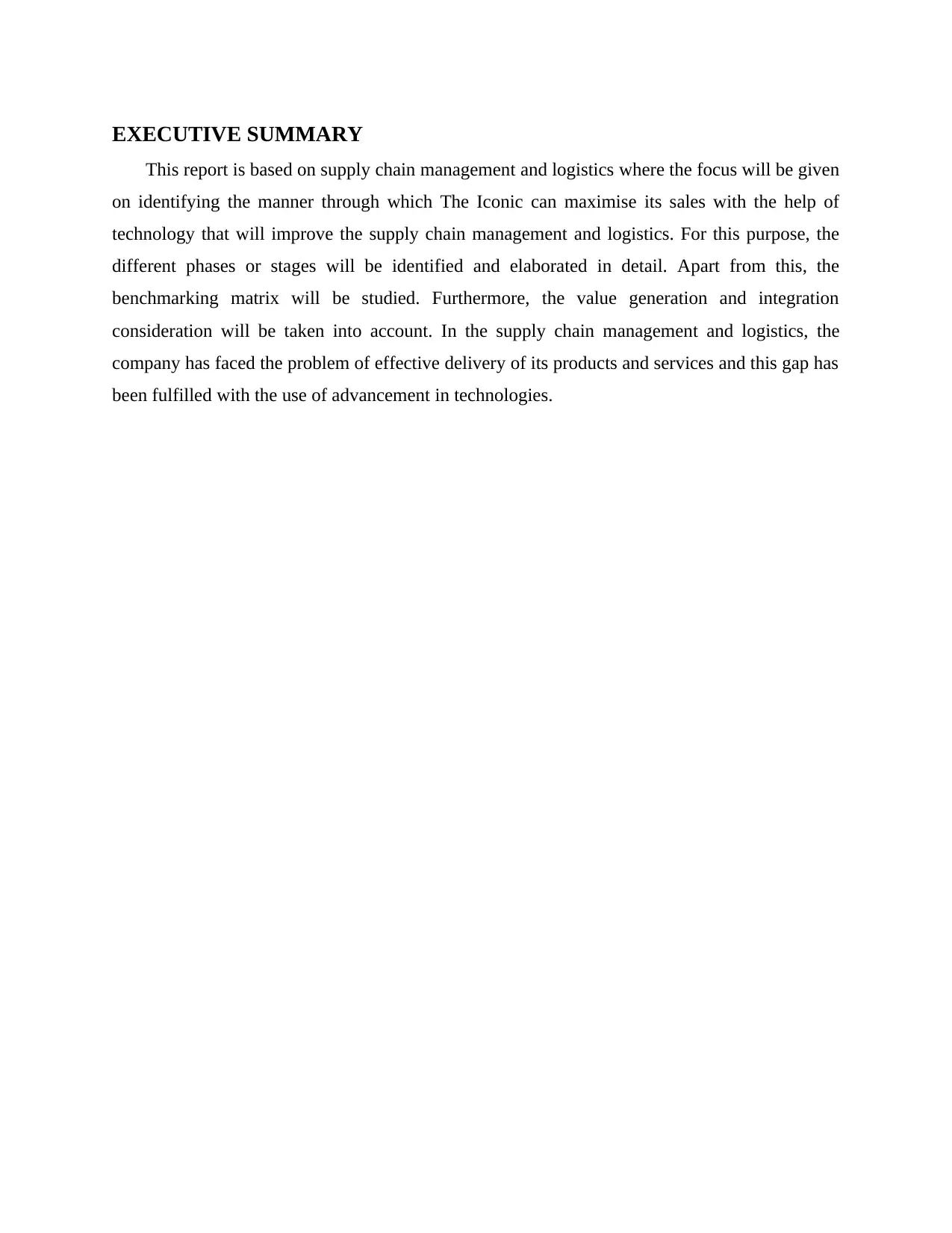
EXECUTIVE SUMMARY
This report is based on supply chain management and logistics where the focus will be given
on identifying the manner through which The Iconic can maximise its sales with the help of
technology that will improve the supply chain management and logistics. For this purpose, the
different phases or stages will be identified and elaborated in detail. Apart from this, the
benchmarking matrix will be studied. Furthermore, the value generation and integration
consideration will be taken into account. In the supply chain management and logistics, the
company has faced the problem of effective delivery of its products and services and this gap has
been fulfilled with the use of advancement in technologies.
This report is based on supply chain management and logistics where the focus will be given
on identifying the manner through which The Iconic can maximise its sales with the help of
technology that will improve the supply chain management and logistics. For this purpose, the
different phases or stages will be identified and elaborated in detail. Apart from this, the
benchmarking matrix will be studied. Furthermore, the value generation and integration
consideration will be taken into account. In the supply chain management and logistics, the
company has faced the problem of effective delivery of its products and services and this gap has
been fulfilled with the use of advancement in technologies.
Paraphrase This Document
Need a fresh take? Get an instant paraphrase of this document with our AI Paraphraser
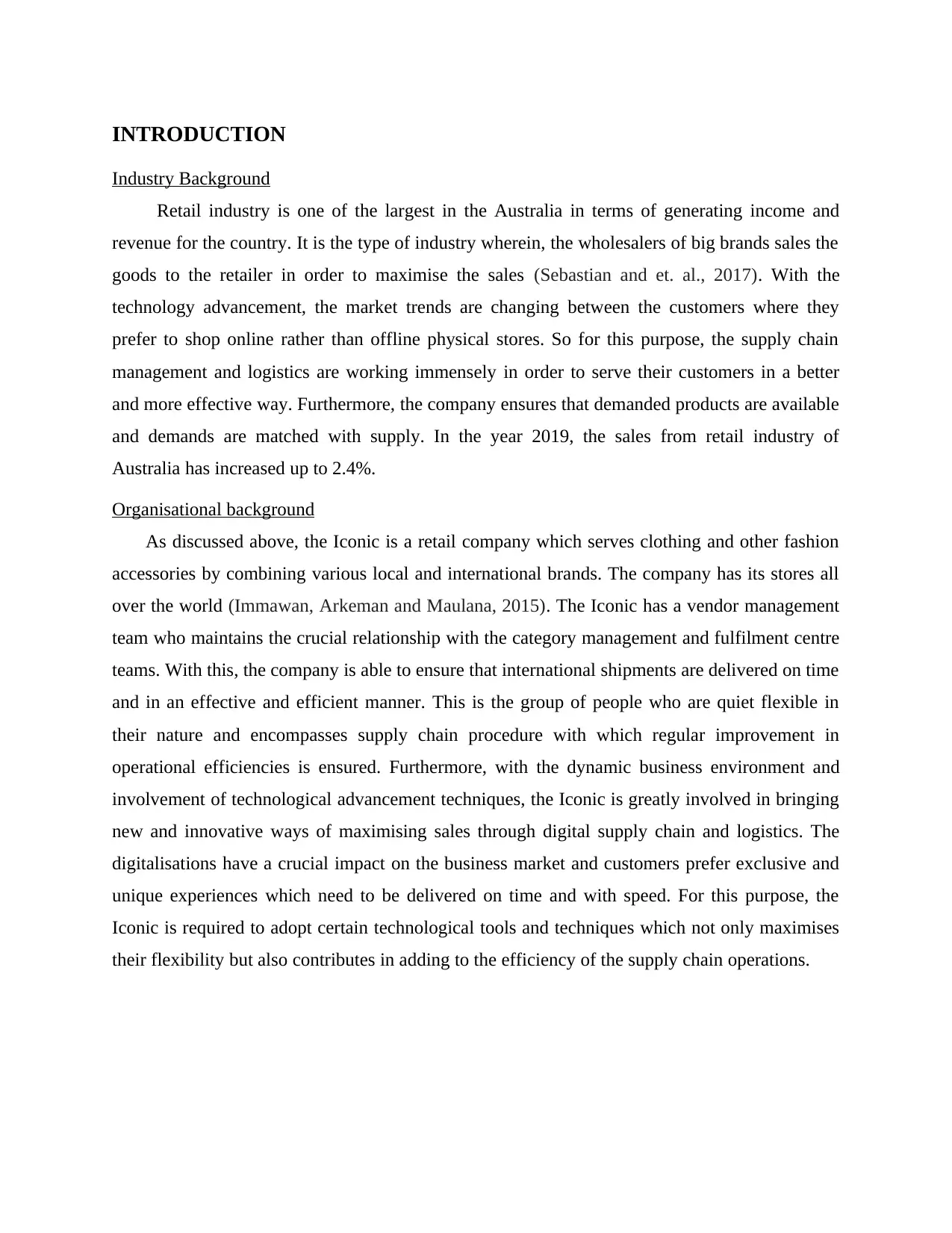
INTRODUCTION
Industry Background
Retail industry is one of the largest in the Australia in terms of generating income and
revenue for the country. It is the type of industry wherein, the wholesalers of big brands sales the
goods to the retailer in order to maximise the sales (Sebastian and et. al., 2017). With the
technology advancement, the market trends are changing between the customers where they
prefer to shop online rather than offline physical stores. So for this purpose, the supply chain
management and logistics are working immensely in order to serve their customers in a better
and more effective way. Furthermore, the company ensures that demanded products are available
and demands are matched with supply. In the year 2019, the sales from retail industry of
Australia has increased up to 2.4%.
Organisational background
As discussed above, the Iconic is a retail company which serves clothing and other fashion
accessories by combining various local and international brands. The company has its stores all
over the world (Immawan, Arkeman and Maulana, 2015). The Iconic has a vendor management
team who maintains the crucial relationship with the category management and fulfilment centre
teams. With this, the company is able to ensure that international shipments are delivered on time
and in an effective and efficient manner. This is the group of people who are quiet flexible in
their nature and encompasses supply chain procedure with which regular improvement in
operational efficiencies is ensured. Furthermore, with the dynamic business environment and
involvement of technological advancement techniques, the Iconic is greatly involved in bringing
new and innovative ways of maximising sales through digital supply chain and logistics. The
digitalisations have a crucial impact on the business market and customers prefer exclusive and
unique experiences which need to be delivered on time and with speed. For this purpose, the
Iconic is required to adopt certain technological tools and techniques which not only maximises
their flexibility but also contributes in adding to the efficiency of the supply chain operations.
Industry Background
Retail industry is one of the largest in the Australia in terms of generating income and
revenue for the country. It is the type of industry wherein, the wholesalers of big brands sales the
goods to the retailer in order to maximise the sales (Sebastian and et. al., 2017). With the
technology advancement, the market trends are changing between the customers where they
prefer to shop online rather than offline physical stores. So for this purpose, the supply chain
management and logistics are working immensely in order to serve their customers in a better
and more effective way. Furthermore, the company ensures that demanded products are available
and demands are matched with supply. In the year 2019, the sales from retail industry of
Australia has increased up to 2.4%.
Organisational background
As discussed above, the Iconic is a retail company which serves clothing and other fashion
accessories by combining various local and international brands. The company has its stores all
over the world (Immawan, Arkeman and Maulana, 2015). The Iconic has a vendor management
team who maintains the crucial relationship with the category management and fulfilment centre
teams. With this, the company is able to ensure that international shipments are delivered on time
and in an effective and efficient manner. This is the group of people who are quiet flexible in
their nature and encompasses supply chain procedure with which regular improvement in
operational efficiencies is ensured. Furthermore, with the dynamic business environment and
involvement of technological advancement techniques, the Iconic is greatly involved in bringing
new and innovative ways of maximising sales through digital supply chain and logistics. The
digitalisations have a crucial impact on the business market and customers prefer exclusive and
unique experiences which need to be delivered on time and with speed. For this purpose, the
Iconic is required to adopt certain technological tools and techniques which not only maximises
their flexibility but also contributes in adding to the efficiency of the supply chain operations.

Operations and Performance
Stages of supply chain management
The supply chain management is the procedure through which the raw materials are
transformed into the finished goods and through suppliers or distributors those products are
supplied to the final destination from where customer can buy them. Each and every product
which has been produced is for the customer only (Laudon and Traver, 2016). This supply chain
is generally the combination of different links wherein the product involved multiple producers
and wholesalers. These products are further stored in the storage houses or warehouses then to
the distribution centres from where the product can be distributed to the different markets where
the demand is high and then finally it reaches to the final customers. This is one of the process
which are followed in retail industries and each links or nodes is involved in adding cost for the
labour, transportation, storage, etc. The following are the different stages of supply chain
management in The Iconic company:
Distributors: They are people who are involved in making the materials or related things
which are required in the stores of the company. They ensure that each store has
availability of respective products and services which are required by the customers. For
instance, in The Iconic , the distributors ensure that each store is serving at least 200 new
products everyday. This means that they are highly innovative in nature and each store is
able to manage the new products (Belvedere and Grando, 2017). Furthermore, the
company has opted for SPS Commerce inc which has successfully connected 97% of
vendor partners in very short duration of time.
Suppliers: They are people who are involved in supplying the necessary raw materials
which are demanded. They will supply those materials to the distributors of the Iconic
company who will be further selling it to the organisation for producing goods and
services (Clarke and Boersma, 2017). In this, the company faces problem of
communication and connecting with the suppliers because it is complex process. For this,
the company has adopted SPS commerce which is a user friendly software and enhances
communication and establishes proper coordination among the different partners and
team members in order to provide the product to the final customers.
Logistics: The logistics is the procedure through which the required resources are
properly managed and stored in the warehouses, it includes the movement and
Stages of supply chain management
The supply chain management is the procedure through which the raw materials are
transformed into the finished goods and through suppliers or distributors those products are
supplied to the final destination from where customer can buy them. Each and every product
which has been produced is for the customer only (Laudon and Traver, 2016). This supply chain
is generally the combination of different links wherein the product involved multiple producers
and wholesalers. These products are further stored in the storage houses or warehouses then to
the distribution centres from where the product can be distributed to the different markets where
the demand is high and then finally it reaches to the final customers. This is one of the process
which are followed in retail industries and each links or nodes is involved in adding cost for the
labour, transportation, storage, etc. The following are the different stages of supply chain
management in The Iconic company:
Distributors: They are people who are involved in making the materials or related things
which are required in the stores of the company. They ensure that each store has
availability of respective products and services which are required by the customers. For
instance, in The Iconic , the distributors ensure that each store is serving at least 200 new
products everyday. This means that they are highly innovative in nature and each store is
able to manage the new products (Belvedere and Grando, 2017). Furthermore, the
company has opted for SPS Commerce inc which has successfully connected 97% of
vendor partners in very short duration of time.
Suppliers: They are people who are involved in supplying the necessary raw materials
which are demanded. They will supply those materials to the distributors of the Iconic
company who will be further selling it to the organisation for producing goods and
services (Clarke and Boersma, 2017). In this, the company faces problem of
communication and connecting with the suppliers because it is complex process. For this,
the company has adopted SPS commerce which is a user friendly software and enhances
communication and establishes proper coordination among the different partners and
team members in order to provide the product to the final customers.
Logistics: The logistics is the procedure through which the required resources are
properly managed and stored in the warehouses, it includes the movement and
⊘ This is a preview!⊘
Do you want full access?
Subscribe today to unlock all pages.

Trusted by 1+ million students worldwide

transportation of stored materials and products, etc. With this, the company is able to
identify the distributors and retailers who have the ability to manage the process. In
Iconic company, SPS commerce in delivering the products and services 24 hours and 7
days a week. Apart from this, it provides opportunity for the logistic partners in adding
value to their work, giving prominence to the services and extending their work to the
final customers.
Benchmarking matrix
Supply chain drivers are the ones which not only enhances the operations and efficiency of
the suppliers but also contributes to the growth and success of the organisation. The effective
supply chain of the company is able to deliver the right product at the right time and at the right
place as well (Min, 2015). Therefore, the iconic company will experience the major supply chain
drivers namely, logistical drivers and cross functional drivers. The following are the major driver
discussed below:
Facilities: The facilities are related to the physical of offline stores where the product is
available for storage or production purposes (Laudon and Laudon, 2016). In Iconic as
well, there are two types of facilities namely, production sites and storage sites. In
production sites that are factories, the product is converted from input to the final output.
Whereas, in storage sites, that is warehouses the product is stored to meet the future
needs and requirements of the customers.
Inventory: It is the combination of all the aspects which comes under the production of
goods that is raw materials, work in progress and then the finished product is a part of
supply chain process. The Iconic company is involved in regularly changing the
inventory policies because of the growing technologies so that the sales can be improved.
The company is involved in taking decisions regarding the cycle, safety and seasonal
inventory.
Transportation: It is one of the most important driver for supply chain management
because without proper transportation, the goods cannot be reached to the final customers
and hence its purpose of producing it cannot be met. Thus, this signifies the movement of
goods and services between different points in the supply chain network. For this
purpose, in order to maximise the sales, the Iconic company has opted for various new
strategies through technological advancement and digitalisation. The company mobile
identify the distributors and retailers who have the ability to manage the process. In
Iconic company, SPS commerce in delivering the products and services 24 hours and 7
days a week. Apart from this, it provides opportunity for the logistic partners in adding
value to their work, giving prominence to the services and extending their work to the
final customers.
Benchmarking matrix
Supply chain drivers are the ones which not only enhances the operations and efficiency of
the suppliers but also contributes to the growth and success of the organisation. The effective
supply chain of the company is able to deliver the right product at the right time and at the right
place as well (Min, 2015). Therefore, the iconic company will experience the major supply chain
drivers namely, logistical drivers and cross functional drivers. The following are the major driver
discussed below:
Facilities: The facilities are related to the physical of offline stores where the product is
available for storage or production purposes (Laudon and Laudon, 2016). In Iconic as
well, there are two types of facilities namely, production sites and storage sites. In
production sites that are factories, the product is converted from input to the final output.
Whereas, in storage sites, that is warehouses the product is stored to meet the future
needs and requirements of the customers.
Inventory: It is the combination of all the aspects which comes under the production of
goods that is raw materials, work in progress and then the finished product is a part of
supply chain process. The Iconic company is involved in regularly changing the
inventory policies because of the growing technologies so that the sales can be improved.
The company is involved in taking decisions regarding the cycle, safety and seasonal
inventory.
Transportation: It is one of the most important driver for supply chain management
because without proper transportation, the goods cannot be reached to the final customers
and hence its purpose of producing it cannot be met. Thus, this signifies the movement of
goods and services between different points in the supply chain network. For this
purpose, in order to maximise the sales, the Iconic company has opted for various new
strategies through technological advancement and digitalisation. The company mobile
Paraphrase This Document
Need a fresh take? Get an instant paraphrase of this document with our AI Paraphraser
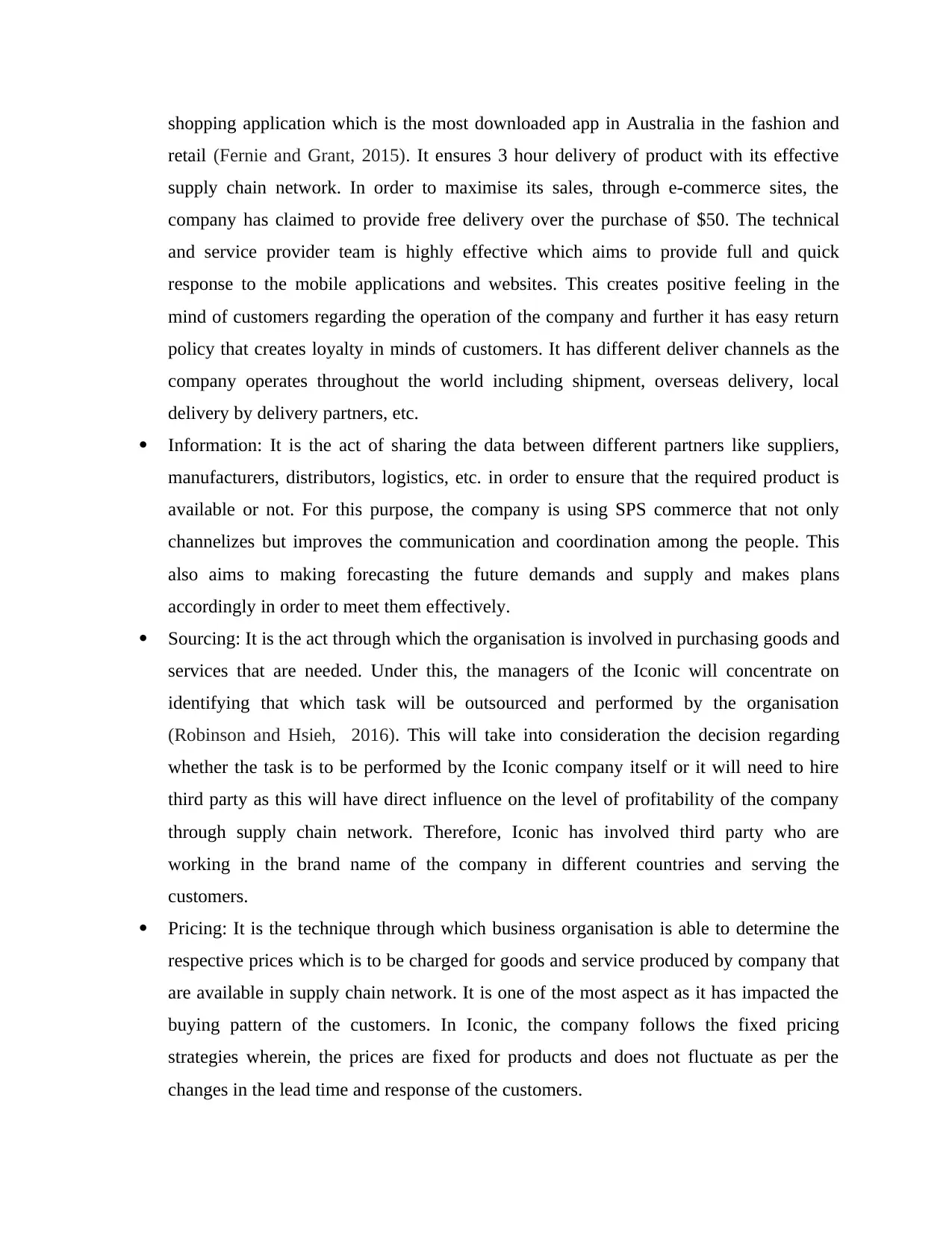
shopping application which is the most downloaded app in Australia in the fashion and
retail (Fernie and Grant, 2015). It ensures 3 hour delivery of product with its effective
supply chain network. In order to maximise its sales, through e-commerce sites, the
company has claimed to provide free delivery over the purchase of $50. The technical
and service provider team is highly effective which aims to provide full and quick
response to the mobile applications and websites. This creates positive feeling in the
mind of customers regarding the operation of the company and further it has easy return
policy that creates loyalty in minds of customers. It has different deliver channels as the
company operates throughout the world including shipment, overseas delivery, local
delivery by delivery partners, etc.
Information: It is the act of sharing the data between different partners like suppliers,
manufacturers, distributors, logistics, etc. in order to ensure that the required product is
available or not. For this purpose, the company is using SPS commerce that not only
channelizes but improves the communication and coordination among the people. This
also aims to making forecasting the future demands and supply and makes plans
accordingly in order to meet them effectively.
Sourcing: It is the act through which the organisation is involved in purchasing goods and
services that are needed. Under this, the managers of the Iconic will concentrate on
identifying that which task will be outsourced and performed by the organisation
(Robinson and Hsieh, 2016). This will take into consideration the decision regarding
whether the task is to be performed by the Iconic company itself or it will need to hire
third party as this will have direct influence on the level of profitability of the company
through supply chain network. Therefore, Iconic has involved third party who are
working in the brand name of the company in different countries and serving the
customers.
Pricing: It is the technique through which business organisation is able to determine the
respective prices which is to be charged for goods and service produced by company that
are available in supply chain network. It is one of the most aspect as it has impacted the
buying pattern of the customers. In Iconic, the company follows the fixed pricing
strategies wherein, the prices are fixed for products and does not fluctuate as per the
changes in the lead time and response of the customers.
retail (Fernie and Grant, 2015). It ensures 3 hour delivery of product with its effective
supply chain network. In order to maximise its sales, through e-commerce sites, the
company has claimed to provide free delivery over the purchase of $50. The technical
and service provider team is highly effective which aims to provide full and quick
response to the mobile applications and websites. This creates positive feeling in the
mind of customers regarding the operation of the company and further it has easy return
policy that creates loyalty in minds of customers. It has different deliver channels as the
company operates throughout the world including shipment, overseas delivery, local
delivery by delivery partners, etc.
Information: It is the act of sharing the data between different partners like suppliers,
manufacturers, distributors, logistics, etc. in order to ensure that the required product is
available or not. For this purpose, the company is using SPS commerce that not only
channelizes but improves the communication and coordination among the people. This
also aims to making forecasting the future demands and supply and makes plans
accordingly in order to meet them effectively.
Sourcing: It is the act through which the organisation is involved in purchasing goods and
services that are needed. Under this, the managers of the Iconic will concentrate on
identifying that which task will be outsourced and performed by the organisation
(Robinson and Hsieh, 2016). This will take into consideration the decision regarding
whether the task is to be performed by the Iconic company itself or it will need to hire
third party as this will have direct influence on the level of profitability of the company
through supply chain network. Therefore, Iconic has involved third party who are
working in the brand name of the company in different countries and serving the
customers.
Pricing: It is the technique through which business organisation is able to determine the
respective prices which is to be charged for goods and service produced by company that
are available in supply chain network. It is one of the most aspect as it has impacted the
buying pattern of the customers. In Iconic, the company follows the fixed pricing
strategies wherein, the prices are fixed for products and does not fluctuate as per the
changes in the lead time and response of the customers.
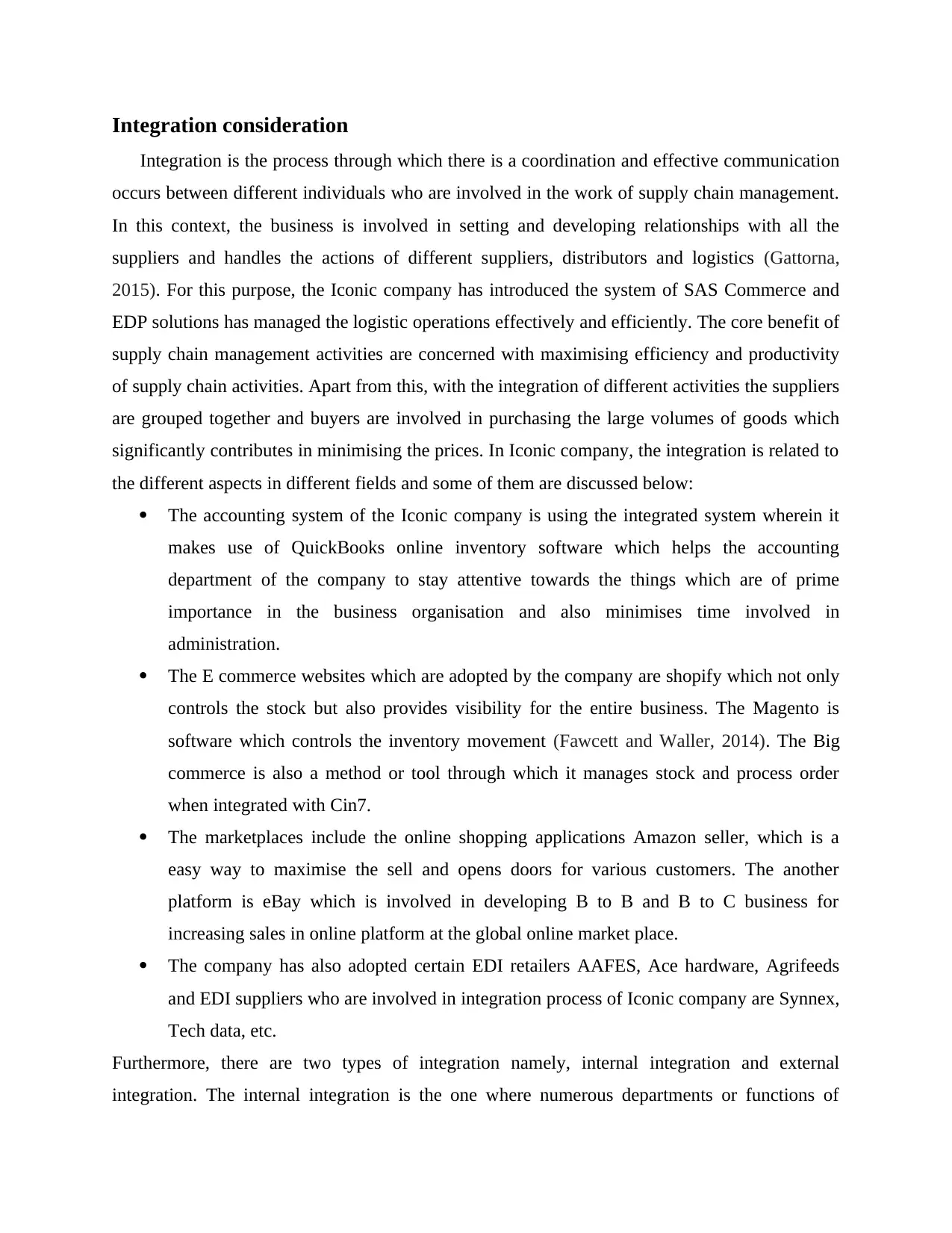
Integration consideration
Integration is the process through which there is a coordination and effective communication
occurs between different individuals who are involved in the work of supply chain management.
In this context, the business is involved in setting and developing relationships with all the
suppliers and handles the actions of different suppliers, distributors and logistics (Gattorna,
2015). For this purpose, the Iconic company has introduced the system of SAS Commerce and
EDP solutions has managed the logistic operations effectively and efficiently. The core benefit of
supply chain management activities are concerned with maximising efficiency and productivity
of supply chain activities. Apart from this, with the integration of different activities the suppliers
are grouped together and buyers are involved in purchasing the large volumes of goods which
significantly contributes in minimising the prices. In Iconic company, the integration is related to
the different aspects in different fields and some of them are discussed below:
The accounting system of the Iconic company is using the integrated system wherein it
makes use of QuickBooks online inventory software which helps the accounting
department of the company to stay attentive towards the things which are of prime
importance in the business organisation and also minimises time involved in
administration.
The E commerce websites which are adopted by the company are shopify which not only
controls the stock but also provides visibility for the entire business. The Magento is
software which controls the inventory movement (Fawcett and Waller, 2014). The Big
commerce is also a method or tool through which it manages stock and process order
when integrated with Cin7.
The marketplaces include the online shopping applications Amazon seller, which is a
easy way to maximise the sell and opens doors for various customers. The another
platform is eBay which is involved in developing B to B and B to C business for
increasing sales in online platform at the global online market place.
The company has also adopted certain EDI retailers AAFES, Ace hardware, Agrifeeds
and EDI suppliers who are involved in integration process of Iconic company are Synnex,
Tech data, etc.
Furthermore, there are two types of integration namely, internal integration and external
integration. The internal integration is the one where numerous departments or functions of
Integration is the process through which there is a coordination and effective communication
occurs between different individuals who are involved in the work of supply chain management.
In this context, the business is involved in setting and developing relationships with all the
suppliers and handles the actions of different suppliers, distributors and logistics (Gattorna,
2015). For this purpose, the Iconic company has introduced the system of SAS Commerce and
EDP solutions has managed the logistic operations effectively and efficiently. The core benefit of
supply chain management activities are concerned with maximising efficiency and productivity
of supply chain activities. Apart from this, with the integration of different activities the suppliers
are grouped together and buyers are involved in purchasing the large volumes of goods which
significantly contributes in minimising the prices. In Iconic company, the integration is related to
the different aspects in different fields and some of them are discussed below:
The accounting system of the Iconic company is using the integrated system wherein it
makes use of QuickBooks online inventory software which helps the accounting
department of the company to stay attentive towards the things which are of prime
importance in the business organisation and also minimises time involved in
administration.
The E commerce websites which are adopted by the company are shopify which not only
controls the stock but also provides visibility for the entire business. The Magento is
software which controls the inventory movement (Fawcett and Waller, 2014). The Big
commerce is also a method or tool through which it manages stock and process order
when integrated with Cin7.
The marketplaces include the online shopping applications Amazon seller, which is a
easy way to maximise the sell and opens doors for various customers. The another
platform is eBay which is involved in developing B to B and B to C business for
increasing sales in online platform at the global online market place.
The company has also adopted certain EDI retailers AAFES, Ace hardware, Agrifeeds
and EDI suppliers who are involved in integration process of Iconic company are Synnex,
Tech data, etc.
Furthermore, there are two types of integration namely, internal integration and external
integration. The internal integration is the one where numerous departments or functions of
⊘ This is a preview!⊘
Do you want full access?
Subscribe today to unlock all pages.

Trusted by 1+ million students worldwide
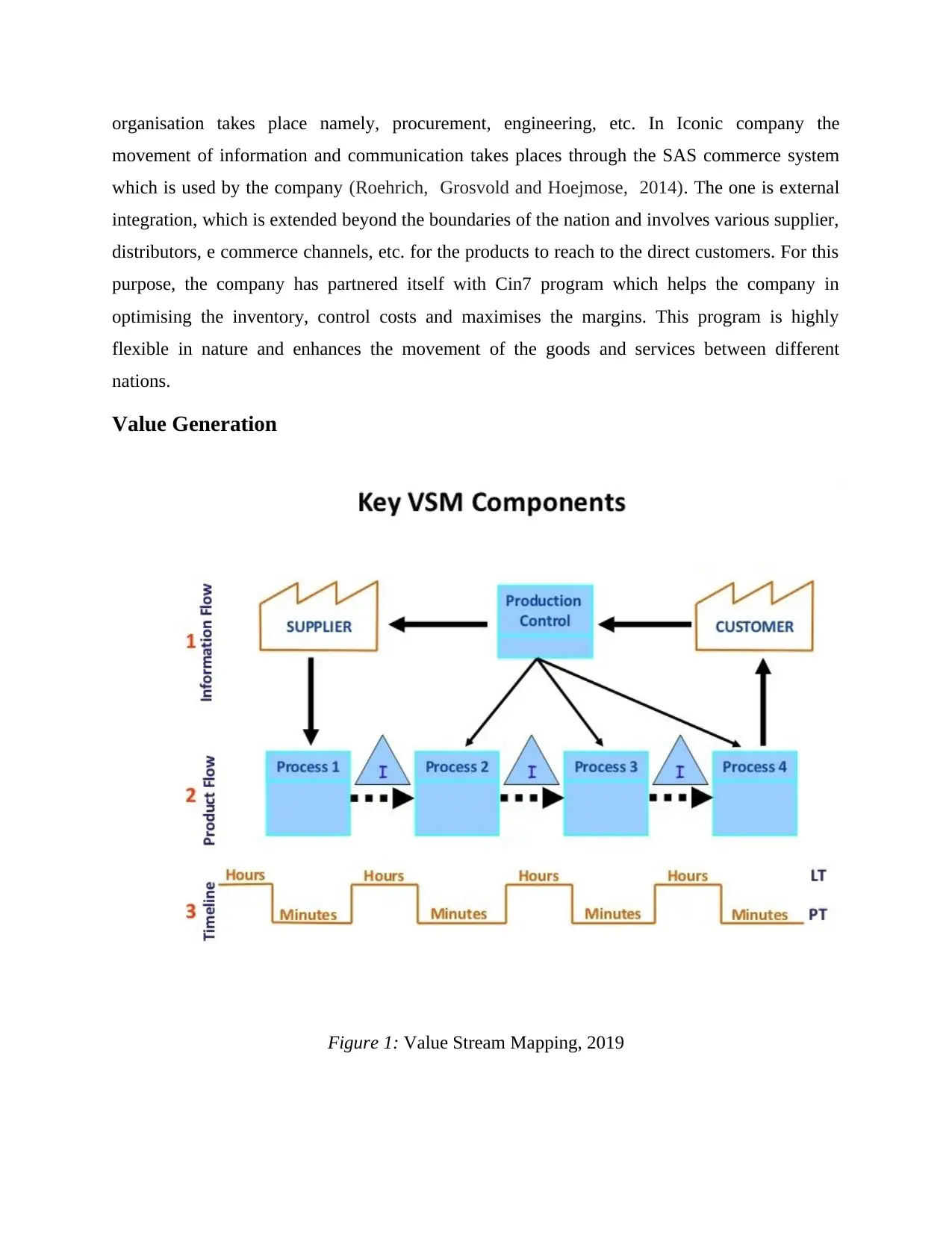
organisation takes place namely, procurement, engineering, etc. In Iconic company the
movement of information and communication takes places through the SAS commerce system
which is used by the company (Roehrich, Grosvold and Hoejmose, 2014). The one is external
integration, which is extended beyond the boundaries of the nation and involves various supplier,
distributors, e commerce channels, etc. for the products to reach to the direct customers. For this
purpose, the company has partnered itself with Cin7 program which helps the company in
optimising the inventory, control costs and maximises the margins. This program is highly
flexible in nature and enhances the movement of the goods and services between different
nations.
Value Generation
Figure 1: Value Stream Mapping, 2019
movement of information and communication takes places through the SAS commerce system
which is used by the company (Roehrich, Grosvold and Hoejmose, 2014). The one is external
integration, which is extended beyond the boundaries of the nation and involves various supplier,
distributors, e commerce channels, etc. for the products to reach to the direct customers. For this
purpose, the company has partnered itself with Cin7 program which helps the company in
optimising the inventory, control costs and maximises the margins. This program is highly
flexible in nature and enhances the movement of the goods and services between different
nations.
Value Generation
Figure 1: Value Stream Mapping, 2019
Paraphrase This Document
Need a fresh take? Get an instant paraphrase of this document with our AI Paraphraser
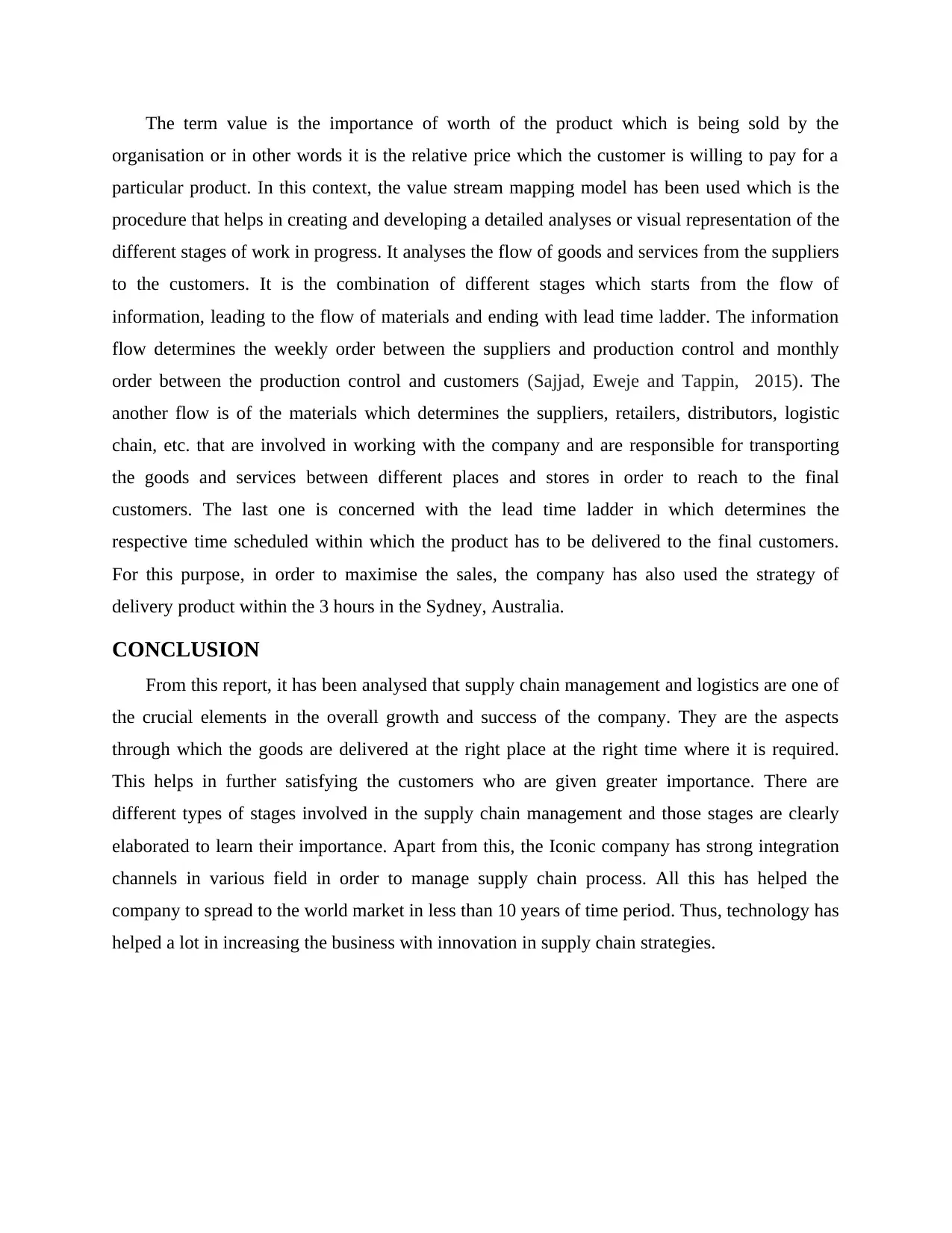
The term value is the importance of worth of the product which is being sold by the
organisation or in other words it is the relative price which the customer is willing to pay for a
particular product. In this context, the value stream mapping model has been used which is the
procedure that helps in creating and developing a detailed analyses or visual representation of the
different stages of work in progress. It analyses the flow of goods and services from the suppliers
to the customers. It is the combination of different stages which starts from the flow of
information, leading to the flow of materials and ending with lead time ladder. The information
flow determines the weekly order between the suppliers and production control and monthly
order between the production control and customers (Sajjad, Eweje and Tappin, 2015). The
another flow is of the materials which determines the suppliers, retailers, distributors, logistic
chain, etc. that are involved in working with the company and are responsible for transporting
the goods and services between different places and stores in order to reach to the final
customers. The last one is concerned with the lead time ladder in which determines the
respective time scheduled within which the product has to be delivered to the final customers.
For this purpose, in order to maximise the sales, the company has also used the strategy of
delivery product within the 3 hours in the Sydney, Australia.
CONCLUSION
From this report, it has been analysed that supply chain management and logistics are one of
the crucial elements in the overall growth and success of the company. They are the aspects
through which the goods are delivered at the right place at the right time where it is required.
This helps in further satisfying the customers who are given greater importance. There are
different types of stages involved in the supply chain management and those stages are clearly
elaborated to learn their importance. Apart from this, the Iconic company has strong integration
channels in various field in order to manage supply chain process. All this has helped the
company to spread to the world market in less than 10 years of time period. Thus, technology has
helped a lot in increasing the business with innovation in supply chain strategies.
organisation or in other words it is the relative price which the customer is willing to pay for a
particular product. In this context, the value stream mapping model has been used which is the
procedure that helps in creating and developing a detailed analyses or visual representation of the
different stages of work in progress. It analyses the flow of goods and services from the suppliers
to the customers. It is the combination of different stages which starts from the flow of
information, leading to the flow of materials and ending with lead time ladder. The information
flow determines the weekly order between the suppliers and production control and monthly
order between the production control and customers (Sajjad, Eweje and Tappin, 2015). The
another flow is of the materials which determines the suppliers, retailers, distributors, logistic
chain, etc. that are involved in working with the company and are responsible for transporting
the goods and services between different places and stores in order to reach to the final
customers. The last one is concerned with the lead time ladder in which determines the
respective time scheduled within which the product has to be delivered to the final customers.
For this purpose, in order to maximise the sales, the company has also used the strategy of
delivery product within the 3 hours in the Sydney, Australia.
CONCLUSION
From this report, it has been analysed that supply chain management and logistics are one of
the crucial elements in the overall growth and success of the company. They are the aspects
through which the goods are delivered at the right place at the right time where it is required.
This helps in further satisfying the customers who are given greater importance. There are
different types of stages involved in the supply chain management and those stages are clearly
elaborated to learn their importance. Apart from this, the Iconic company has strong integration
channels in various field in order to manage supply chain process. All this has helped the
company to spread to the world market in less than 10 years of time period. Thus, technology has
helped a lot in increasing the business with innovation in supply chain strategies.
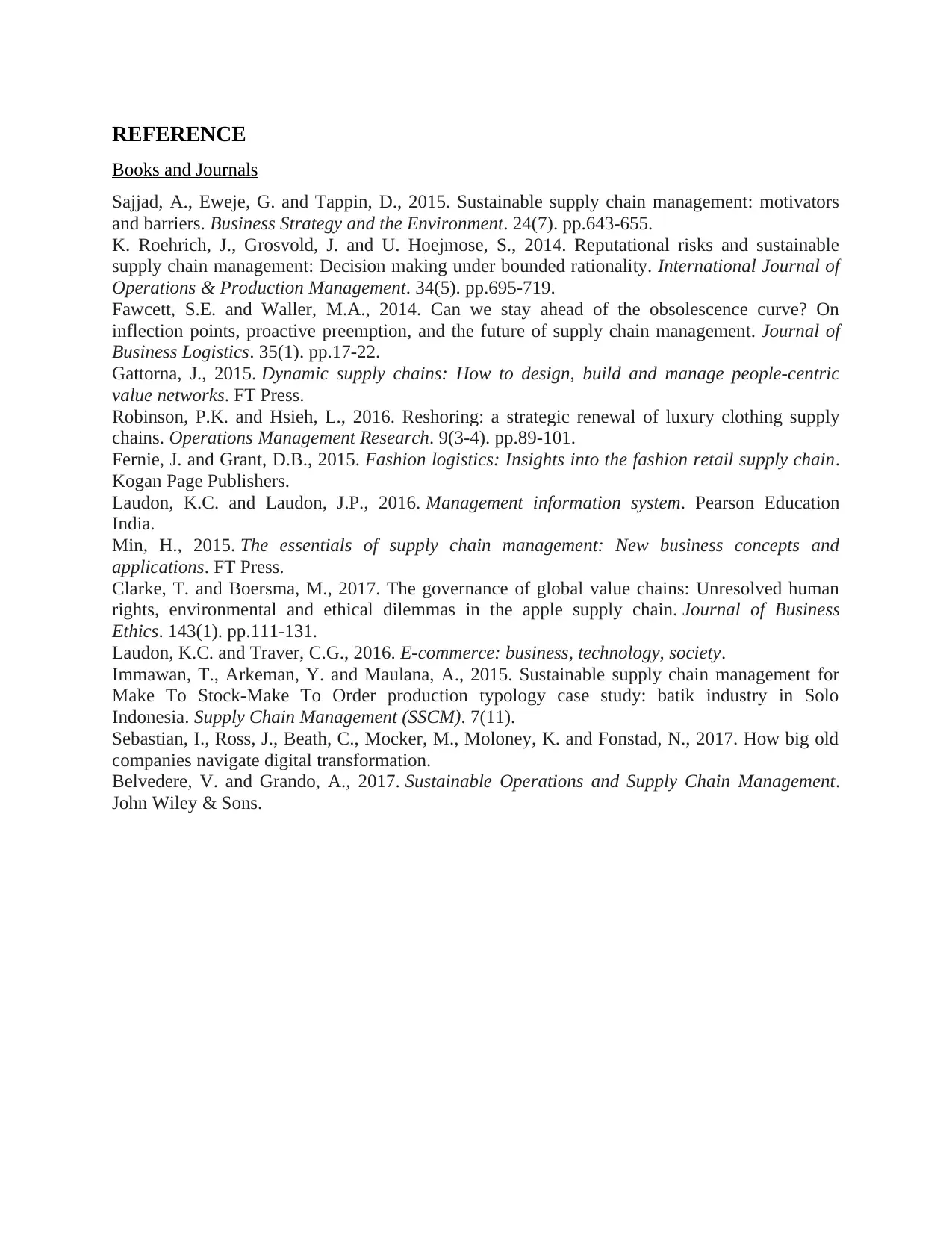
REFERENCE
Books and Journals
Sajjad, A., Eweje, G. and Tappin, D., 2015. Sustainable supply chain management: motivators
and barriers. Business Strategy and the Environment. 24(7). pp.643-655.
K. Roehrich, J., Grosvold, J. and U. Hoejmose, S., 2014. Reputational risks and sustainable
supply chain management: Decision making under bounded rationality. International Journal of
Operations & Production Management. 34(5). pp.695-719.
Fawcett, S.E. and Waller, M.A., 2014. Can we stay ahead of the obsolescence curve? On
inflection points, proactive preemption, and the future of supply chain management. Journal of
Business Logistics. 35(1). pp.17-22.
Gattorna, J., 2015. Dynamic supply chains: How to design, build and manage people-centric
value networks. FT Press.
Robinson, P.K. and Hsieh, L., 2016. Reshoring: a strategic renewal of luxury clothing supply
chains. Operations Management Research. 9(3-4). pp.89-101.
Fernie, J. and Grant, D.B., 2015. Fashion logistics: Insights into the fashion retail supply chain.
Kogan Page Publishers.
Laudon, K.C. and Laudon, J.P., 2016. Management information system. Pearson Education
India.
Min, H., 2015. The essentials of supply chain management: New business concepts and
applications. FT Press.
Clarke, T. and Boersma, M., 2017. The governance of global value chains: Unresolved human
rights, environmental and ethical dilemmas in the apple supply chain. Journal of Business
Ethics. 143(1). pp.111-131.
Laudon, K.C. and Traver, C.G., 2016. E-commerce: business, technology, society.
Immawan, T., Arkeman, Y. and Maulana, A., 2015. Sustainable supply chain management for
Make To Stock-Make To Order production typology case study: batik industry in Solo
Indonesia. Supply Chain Management (SSCM). 7(11).
Sebastian, I., Ross, J., Beath, C., Mocker, M., Moloney, K. and Fonstad, N., 2017. How big old
companies navigate digital transformation.
Belvedere, V. and Grando, A., 2017. Sustainable Operations and Supply Chain Management.
John Wiley & Sons.
Books and Journals
Sajjad, A., Eweje, G. and Tappin, D., 2015. Sustainable supply chain management: motivators
and barriers. Business Strategy and the Environment. 24(7). pp.643-655.
K. Roehrich, J., Grosvold, J. and U. Hoejmose, S., 2014. Reputational risks and sustainable
supply chain management: Decision making under bounded rationality. International Journal of
Operations & Production Management. 34(5). pp.695-719.
Fawcett, S.E. and Waller, M.A., 2014. Can we stay ahead of the obsolescence curve? On
inflection points, proactive preemption, and the future of supply chain management. Journal of
Business Logistics. 35(1). pp.17-22.
Gattorna, J., 2015. Dynamic supply chains: How to design, build and manage people-centric
value networks. FT Press.
Robinson, P.K. and Hsieh, L., 2016. Reshoring: a strategic renewal of luxury clothing supply
chains. Operations Management Research. 9(3-4). pp.89-101.
Fernie, J. and Grant, D.B., 2015. Fashion logistics: Insights into the fashion retail supply chain.
Kogan Page Publishers.
Laudon, K.C. and Laudon, J.P., 2016. Management information system. Pearson Education
India.
Min, H., 2015. The essentials of supply chain management: New business concepts and
applications. FT Press.
Clarke, T. and Boersma, M., 2017. The governance of global value chains: Unresolved human
rights, environmental and ethical dilemmas in the apple supply chain. Journal of Business
Ethics. 143(1). pp.111-131.
Laudon, K.C. and Traver, C.G., 2016. E-commerce: business, technology, society.
Immawan, T., Arkeman, Y. and Maulana, A., 2015. Sustainable supply chain management for
Make To Stock-Make To Order production typology case study: batik industry in Solo
Indonesia. Supply Chain Management (SSCM). 7(11).
Sebastian, I., Ross, J., Beath, C., Mocker, M., Moloney, K. and Fonstad, N., 2017. How big old
companies navigate digital transformation.
Belvedere, V. and Grando, A., 2017. Sustainable Operations and Supply Chain Management.
John Wiley & Sons.
⊘ This is a preview!⊘
Do you want full access?
Subscribe today to unlock all pages.

Trusted by 1+ million students worldwide
1 out of 12
Related Documents
Your All-in-One AI-Powered Toolkit for Academic Success.
+13062052269
info@desklib.com
Available 24*7 on WhatsApp / Email
![[object Object]](/_next/static/media/star-bottom.7253800d.svg)
Unlock your academic potential
Copyright © 2020–2025 A2Z Services. All Rights Reserved. Developed and managed by ZUCOL.





